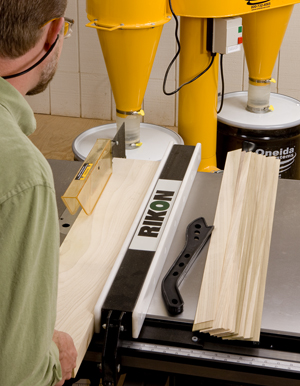
I have a right-tilt Ryobi BT3000 table saw. I love it and it works great, but I never feel comfortable when I tilt the blade for a beveled cut. I am right-handed and usually have the fence on the right side of the blade, but move it to the left side when the blade is tilted. Is there any trick to feeling more comfortable cutting this way? – John Boersma
Rob Johnstone: I had a BT3000 for several years and really liked that saw, too. I am not certain what is causing you to feel uneasy with the saw when you are bevel cutting, but I never advise folks to keep doing something that does not feel safe. Speaking personally, as I increase my skill and knowledge of a specific task, my comfort level usually increases. But here is a curious thing: a person can feel comfortable and at ease, and really be doing something totally unsafe. When it comes to tool operation, understanding and practicing proper technique is the best way to stay safe. Some information that might be useful to you is a series of articles on using the table saw that you can find at the following link.
Chris Marshall: My saw tilts left, and I am a righty, so I’m fortunate not to have to rethink how it would feel to have the blade tilt the other way and move the fence opposite of where it’s already comfortable for me. I bet that is strange. But I agree with Rob: caution and a bit of unease is not necessarily a bad thing. It makes you mindful that the bevel-cutting operation is different from your run-of-the-mill rip and crosscuts. I think the only cure to remedy unease (if you are already practicing safe technique) is to keep making more safe and successful bevel cuts. There’s no other trick to it.
Tim Inman: My new chainsaw came with a manual which includes some important advice. It applies equally to chainsaws and to table saws. It says, “Always remember, there is no such thing as a minor chainsaw accident.” If you are uncomfortable making any kind of cut with virtually any kind of saw, then DO NOT DO IT. It’s just that simple. Find another way, and come back some other day to perfect your original idea.
That said, I’d suggest that you practice, practice, practice. Do not practice with little boards, though. Those little boards are the ones you’ll find yourself picking out of your teeth later on! Practice with easy to cut, stable wood. I’d use boards at least 3 or 4 feet long. Use a pusher to get the wood through the cut. DO NOT use your fingers. Using a pusher will give you a ton more confidence, and a lot more safety — and control! I think you’ll find that after some experience, this cutting setup is actually safer, and more comfortable. Now, it is different, and uneasy for you. Practice. If practice doesn’t make it better, then find another saw that you like. No machine is good enough to shorten your digits for you — or spoil your desire to use it for woodworking. Be the master of the tools, don’t let them master you.







